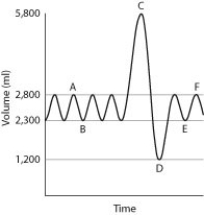Multiple Choice
Physicians routinely give their patients pulmonary function tests in order to measure characteristics of lung function. The most common of these tests, spirometry, measures both the volume and the speed of air entering and exiting the lungs. In this test, a person first breathes normally while breathing into a spirometer, a machine that measures air volume and air speed. Then the person takes the deepest breath possible and exhales as hard as possible for 6 seconds into the spirometer. The resulting data are plotted on a graph of volume (y axis) versus time (x axis) . Spirometry is useful not only for assessing lung function in healthy patients but also for characterizing patients with lung conditions such as pulmonary fibrosis, asthma, or emphysema.
A sample graph for a healthy adult male is shown below. Normal breathing occurs between points A and B, a maximal inhalation occurs at point C, and a maximal exhalation occurs at point D. Normal breathing resumes between points E and F.

-For this data set, what is the vital capacity?
A) 1,200 mL
B) 2,800 mL
C) 4,600 mL
D) 5,800 mL
Correct Answer:

Verified
Correct Answer:
Verified
Q38: Some crocodiles and turtles have an exceptional
Q39: Animals that effectively use their body surface
Q40: If the hemoglobin molecules in your red
Q41: When bar-headed geese fly at very high
Q42: Pulmonary fibrosis is a lung disease that
Q44: When bar-headed geese fly at very high
Q45: Which respiratory structure likely has the largest
Q46: In the countercurrent exchange system of fish
Q47: Which of the following contributes to gas
Q48: During gas exchange, body cells<br>A) take up